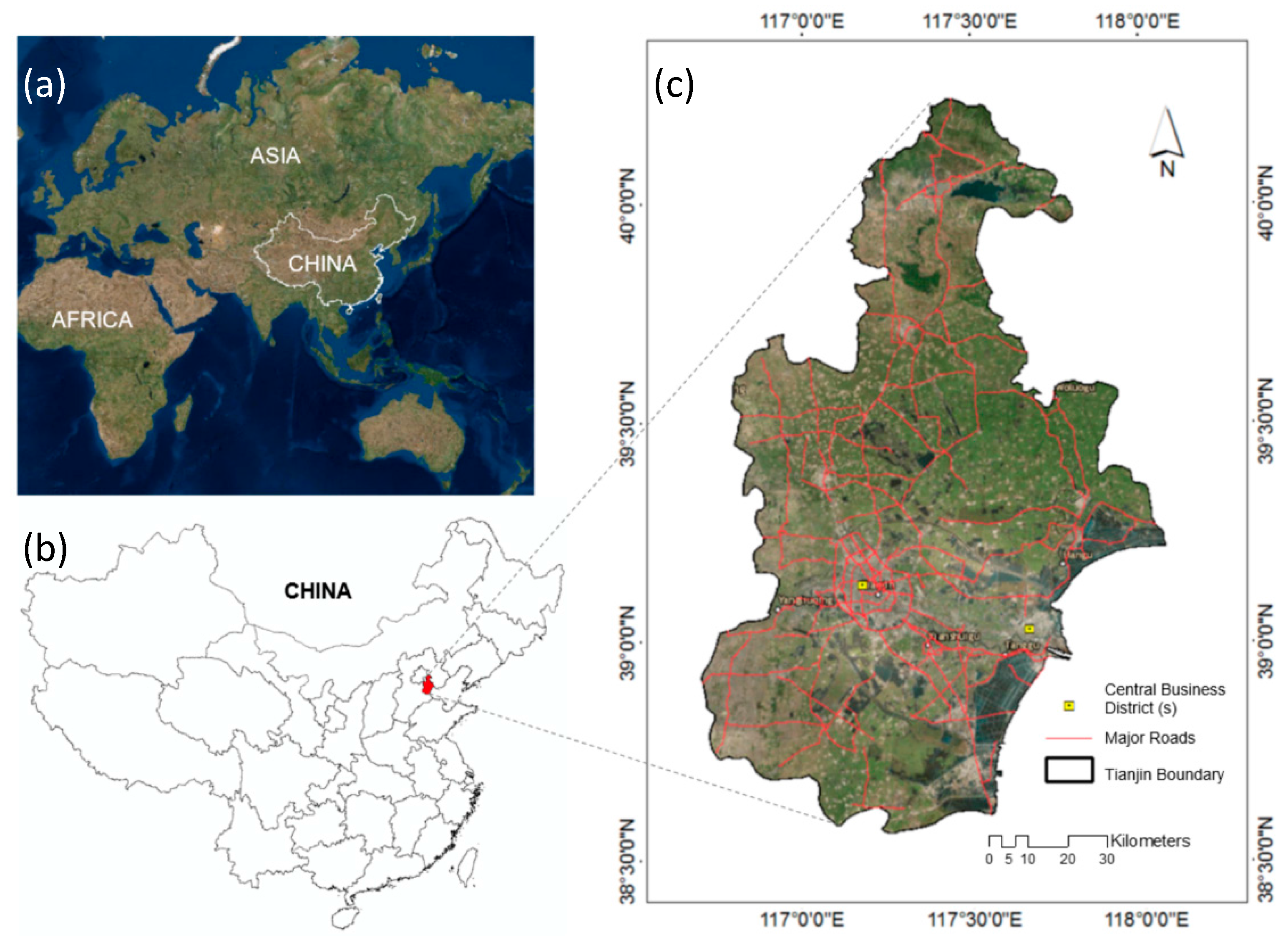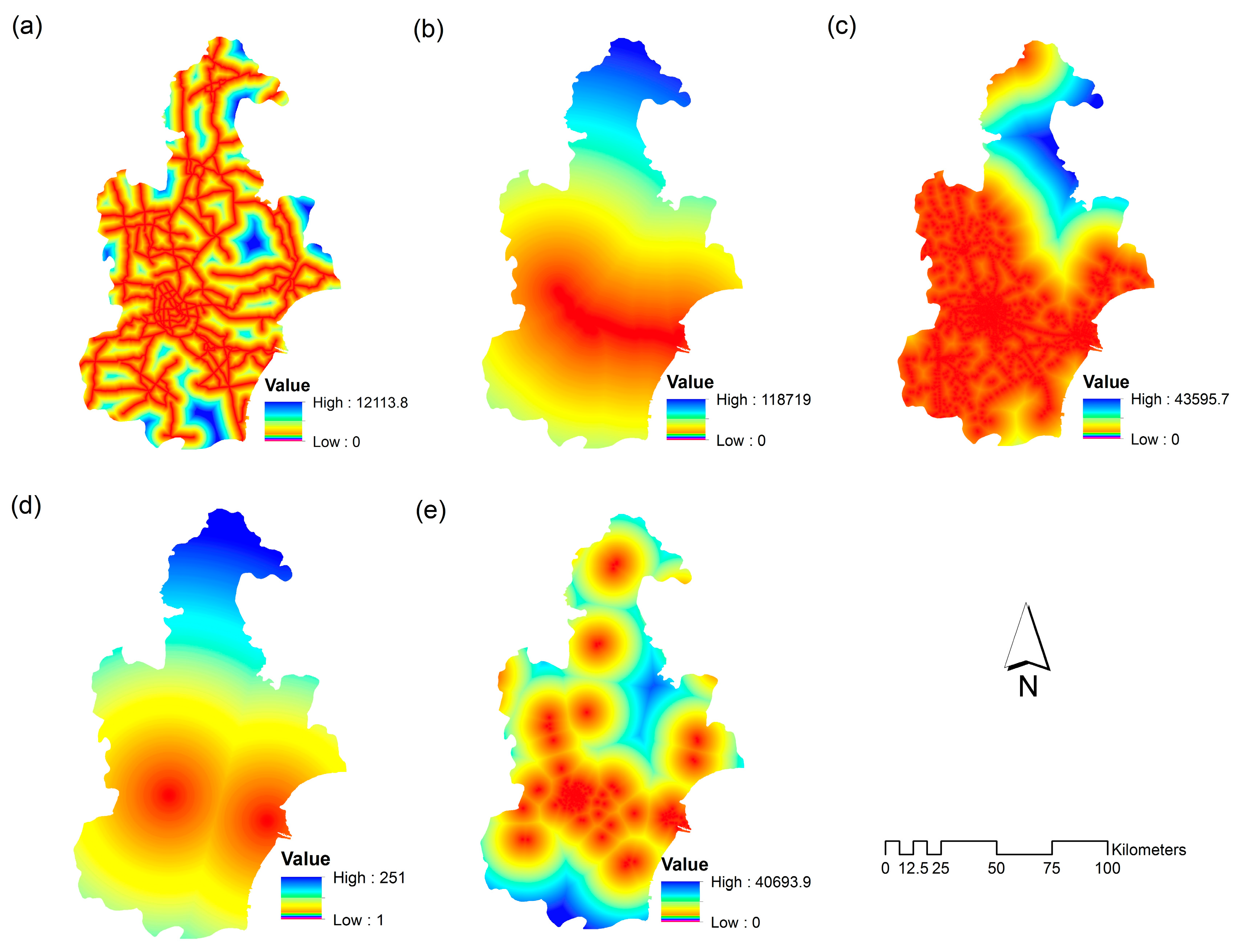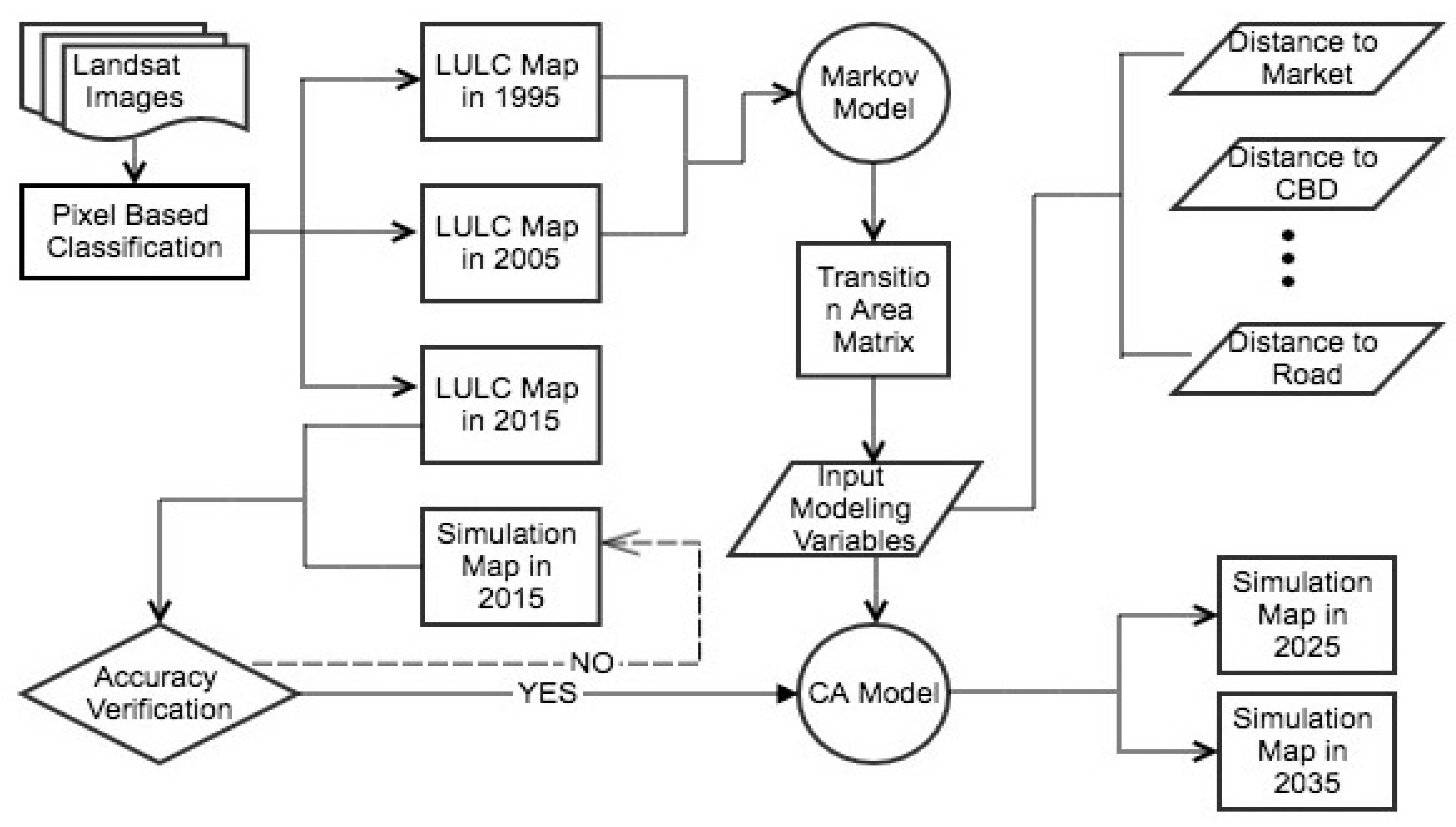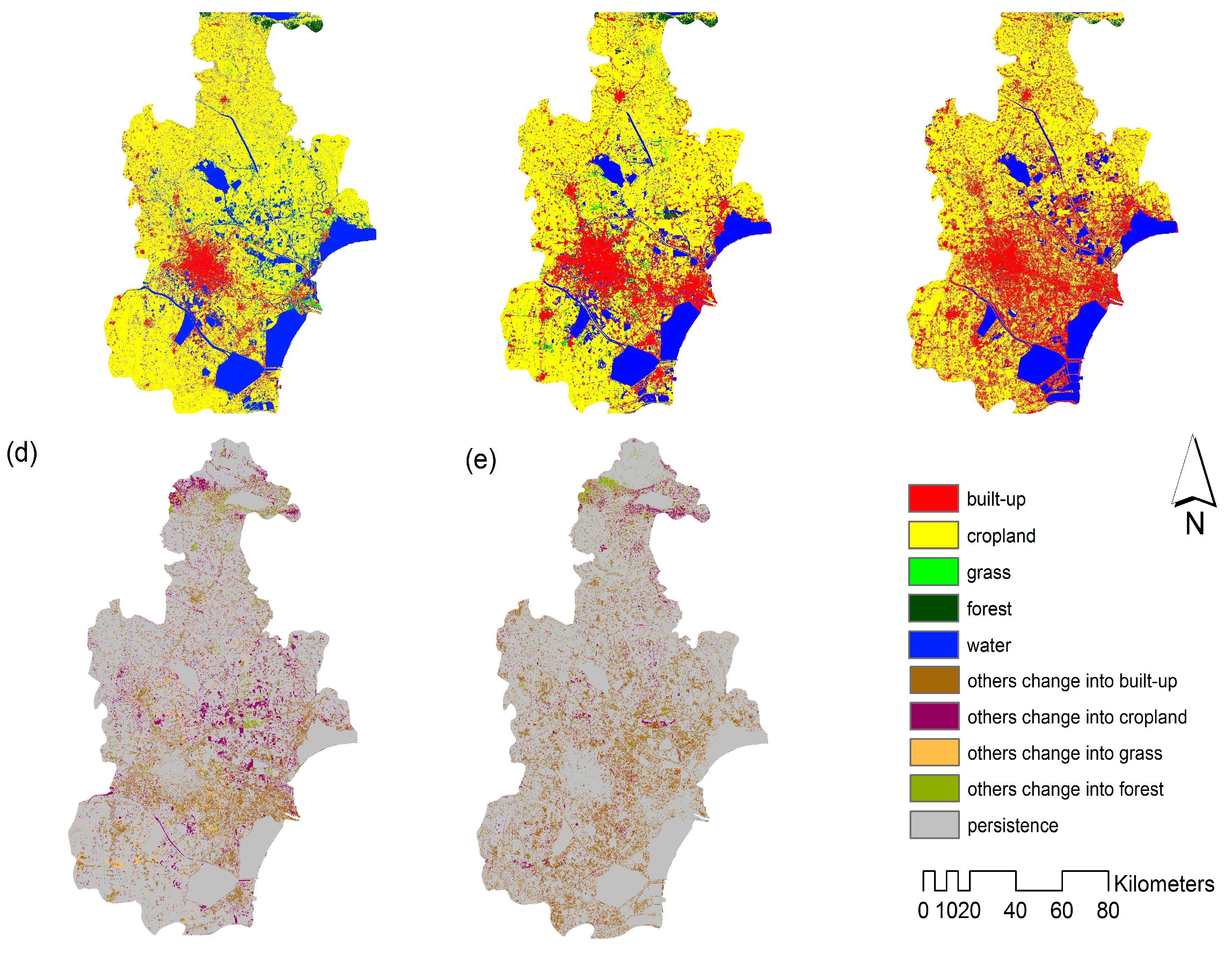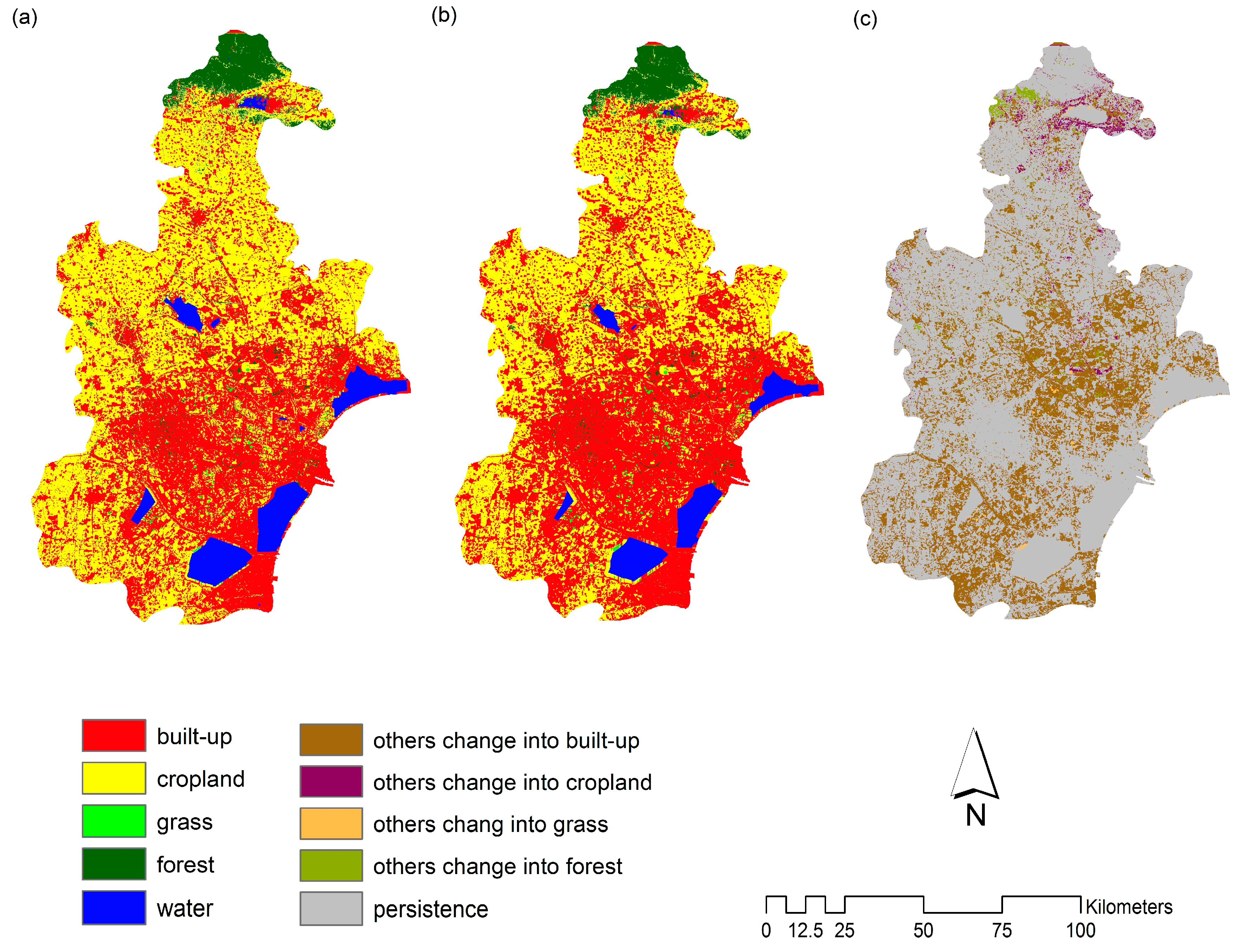1. Introduction
Urban areas around the world are currently expanding at an astonishing rate. An increase of 58,000 km
2 for urban land areas has been observed from 1970 to 2000 [
1]. Rapid economic development and population growth are the main driving forces of urbanization. In the past few decades, the world has achieved steady economic growth, which is around 3% annually. Currently, the world population continues to grow though more slowly than in the recent past. Up to 2017, the world population has reached 7.5 billion. The world has been powerfully shaped by the interplay of economic development, population growth, and urbanization. It has been estimated that global urban land cover will have a likely increase of 1,527,000 km
2 by 2030 [
1].
Urbanization is especially pronounced in developing countries, due to rapid economic development and population growth [
1]. As one of the main developing countries, China has experienced the highest rates of urban land expansion. It is recorded that annual rates of urban land expansion in China vary from 13.3% for coastal areas to 3.9% for the western regions [
2].
The implication of urbanization is profound. It contributes to the improvement of people’s live standards, efficient resource utilization, and mitigation of climate change. For example, with high residential density, energy consumption and vehicle miles traveled could be reduced, thus offsetting greenhouse gas emissions. At the same time, negative impacts brought by urbanization should not be neglected. Air pollution, traffic congestion, food shortages, forest decreasing and species extinction have occurred under rapid developments.
Urbanization causes a dramatic change to the urban land use system [
3]. For example, Beijing, the capital of China, is quite different now compared to 50 years ago, when subways, highways, and factories rarely operated [
4]. Because of human activity, a lot of cropping land has been changed into built-up area, and the scale of the city has expanded. This process brings about benefits as well as problems.
Urbanization is one of the most complex processes that involve landscape changes. The modeling variables and mechanism of LULC are spatiotemporally changing. Under these circumstances, relevant issues need to be discussed and investigated in depth [
5]. Analysis of LULC changes is regarded to be a useful approach to capture the urban trend and to forecast its features. In the modern era, it is essential and necessary to have a comprehensive simulation for urban development [
6]. RS and GIS are essential tools in capturing the spatial characteristics of LULC changes in a practicable way [
7]. Relying on these spatial data, urban models are usually employed in considering the pattern of urbanization [
8]. With the aid of urban growth models, researchers are able to calculate the structure and behavior of the urban system and simulate future conditions [
9].
RS data has been used as a source of information on urban growth and urban morphology, as remote sensing can provide spatiotemporal data on urbanization processes, while census data is limited [
10]. Specifically, RS data and its techniques are increasingly used in research aimed at operational monitoring on urbanization [
11]. For developing countries, remote sensing data are particularly useful due to the cost and time associated with the method. Several studies have demonstrated the applicability of RS for depicting LULC change in some cities [
12].
Urban models attempt to describe the urban system using mathematical equations [
13]. They can be used to make a representation of the urban system and deal with the interaction of LULC activity in different areas. The reasons, processes, and result of LULC modification are determined by the interaction of many factors and policies. Under these circumstances, urban models have become a significant step for predicting LULC changes. Relying on currently available data or conditions, combined with factors (such as population, economic and politics) and modeling variables (such as distance to built-up, distance to the central business district (CBD), distance to road, etc.), urban models could potentially be used to model LULC and forecast future development condition in the same area. As it is extremely helpful for decision-making and policy formulation, a considerable amount of research has been conducted on LULC. However, the adoption of Markov and Cellular Automata is rarely seen.
As one of the four municipalities, Tianjin, a harbor city in northern China, has experienced lasting urbanization and industrialization, which brings about LULC change. After few decades of development, urban areas have expanded significantly. Given its important position in north China, there is still great potential for population growth and economic development. Considering the trend of urbanization, industrialization, and the ongoing LULC change in Tianjin, modeling LULC change and foresting its tendency are great need for urban planners.
Therefore, the primary objective of this study was to investigate the LULC changes in Tianjin city. Moreover, we aimed to simulate future LULC development to support urban planning initiatives. This study focused on the period from 1995 to 2015, during which the urbanization process is remarkable. To do so, we firstly produced LULC maps with five classifications at three time points (1995, 2005, and 2015). By comparing LULC at these time points, it was found that a large number of croplands had been converted into built-up areas. Then, variables for the CA model were constructed. To project the LULC in 2025 and 2035, a suitable set of transition rules was established to identify neighborhood interactions. Based on Markov and CA models, supplemented with dynamic variables, LULC in 2025 and 2035 were projected. Simulation result showed that built-up area will continue expanding in the central and southeast harbor areas, mainly from cropland. This paper ends with a discussion on the trend of LULC in Tianjin and the potential implications of these, which should be particularly known and addressed during city planning.
GIS, the Markov model, and CA model were employed as the main methods of analysis. It contributes to the understanding of LULC change in Tianjin area, which facilitates future planning. Our application also demonstrates the potential of remote sensing techniques in modeling LULC, and providing information for city planners.
4. Discussion
4.1. Trend of LULC in Tianjin and China
The LULC map in 1995, 2005, and 2015 showed that built-up areas increased continuously and steadily. In 1995, built-up areas were concentrated only in the center of Tianjin city. In 2005, built-up areas in center expanded and it started to grow in harbor areas, along with the coastal line. The expansion in harbor area was accompanied by the establishment and development of Binhai District, which is regarded as the sub-center of Tianjin city. Notably, urban areas sprawl along one of the main rivers in Tianjin, Haihe. Consequently, the main urban area and the newly developed built-up areas in coastal regions are connected. In 2015, built-up areas further extended. As a result, built-up areas in these two regions have integrated as a whole, ranging from central regions to the harbor.
As shown by the simulated LULC maps in 2025 and in 2035, built-up areas will further grow. A large quantity of cropland will be converted into built-up regions. These changes will mainly take place in the southeast part. This is understandable since Tianjin city is one of the main harbor cities in northern China. The proximity to coastal regions improves access to transport infrastructure.
The LULC change in Tianjin city is just a sample of what has happened in the whole country during the past several decades. After China’s reform and establishment of opening-up policies in the 1980s, LULC change in China has been dramatic, together with economic development, industrialization, and the relaxation of Hukou system, which restricts the mobility of populations across regions. Each year, millions of rural populations settle down in urban areas. In 2015, the urbanization rate in China reached 56.10% from 35.39% in 2000. Such a trend is expected to continue, based on the experience of other countries. It is widely believed that the urbanization rate will be around 70% to 80% if economic growth continues. Therefore, LULC change will be lasting, along with urbanization.
However, from a nationwide perspective, such transformation is not homogeneous. Due to the uneven distribution of public resources such as education, medical care, and amenities, populations are mainly attracted to metropolitan areas. As a consequence, LULC change in big cities is more pronounced and rapid [
40]. Tianjin, as one of the four municipalities, is a popular destination for rural residents moving to urban areas. Therefore, LULC change in Tianjin will also be huge, due to ongoing urbanization.
4.2. Methodological Issues
The CA model is an essential method for analyzing LULC changes and urban growth. Compared with other studies investigating urban growth, the adoption of the CA model in this context proved to be appropriate, based on its excellent performance. Research also exists in the literature that adopt CA model. For example, in one study investigating Logan city, Australia, researchers combined the self-adaptive genetic algorithm (SAGA) and the CA model to simulate urban growth using SAGA transition rules and spatial analysis in the CA model, and yielded a FoM value of 7.5% [
41]. In our study, we obtained a FoM value of 14.73% with five categories in Tianjin city. In addition, the values of K-histogram, K-location and K-simulation were found to be 0.83, 0.86 and 0.51. All these indices suggest that the CA model was suitable for the study area and our dataset.
Without the adoption of spatial analyzing models, such as the CA model, traditional LULC research focusing on category change only derives numeric results. For example, in one study investigating LULC along Jinsha River, China, researchers combined statistical factors into their economic model and calculated the statistical result of LULC changes [
42]. In order to produce better simulations for urbanization, spatial distribution should not be neglected. In our study, we implemented the CA model, integrated with the Markov model to successfully account for spatial dimensions.
Although the CA model has several merits, it suffers from certain limitations. As an example, if LULC in the far future is projected, almost all categories will end up changing into built-up areas since the CA model assumes a constant transition probability. In this simulation of LULC by the CA model, all point in the near or far future could only be based on the actual conditions of 2005 and 2015. However, these were the periods when urbanization speed in Tianjin was the highest. Such a high change of rate is not likely to persist in the long run. This trend will slow down inevitably such that the CA model is not capable of capturing the “dynamics of dynamics”. Nevertheless, despite the above limitation, using the Markov model and the CA model is still a useful method for simulating LULC conditions in the near future, and the results are critical for making urbanization plans.
4.3. Potential Implications of LULC Change
LULC change in 1995, 2005 and 2015 revealed that a large amount of cropland was converted into built-up areas. Simulation results for 2025 and 2035 also suggest that such a trend will continue in the near future. Although our study only focuses on Tianjin city, such a phenomenon prevails nationwide in China. The fast expansion of urban areas will bring about challenges in several aspects.
First of all, the construction of built-up areas is mainly at the cost of cropland. The farming population is also decreasing along with urbanization. For a country whose farmland per capita is below half the world average, the decline in farmland will undermine the food security of China. It may even influence the world food market if domestic production cannot meet global demands. Considering the large size of the Chinese population, such implications could be huge worldwide. In the last decade, the import volume of agricultural products and food has increased continuously. China has become the main buyer for certain agricultural commodities, such as soybean. Under such circumstances, improving agriculture productivity and maintaining food self-sufficiency is vital for the food security of China, and for the world.
Second, the change in land cover might influence the city climate. Evidence exists that urbanization advances the start of the growing season, and postpones the end of the growing season, prolonging the growing season length [
43]. In the past half century, wetlands in Tianjin city have vanished dramatically. The ongoing urbanization process will further induce the reduction of green land, which makes the city vulnerable to the urban heat island effects.
Moreover, urbanization will increase the demand for water and sewage disposal capacity. Northern China has long suffered from water shortage. Although projects transferring water from the south to the north have been implemented two decades ago, water resources are still limited in these regions. It will be especially challenging for Tianjin, since its per capita water availability is the lowest among all provinces. Under such circumstances, measures that improve water usage efficiency, such as water reclamation, should be taken into consideration in city planning.
Finally, urban sprawl is a major driving force that increases non-point source pollution [
44]. In recent years, in the North China Plain, where Tianjin city is located, air pollution, such as PM 2.5, has intensified significantly. This imposes damage to the health of residents, and reduces the living quality of people tremendously. High population density, industry production, and traffic in urban areas contribute substantially to these pollutions. Given that the urbanization in Tianjin city will be dramatic, such concerns should be made aware to city planners.
5. Conclusions
LULC changes show the track of urbanization, and the LULC condition depends on the composition of the urban spatial form. Urban land management and urban planning, as well as ecosystem monitoring, closely rely on precise and timely information about LULC changes in urban areas. The urbanization model, complemented with GIS and remote sensing techniques, is an essential part of analyzing the trend of spatial LULC changes.
Due to the large population and rapid economic growth in China, LULC changes at an unexpected rate [
45]. To better understand the process and driving force of LULC in countries experiencing rapid urbanization, this study investigated historical land cover transitions and simulated future LULC changes in Tianjin city, China, with CA and Markov models.
In this study, the landscape of LULC in 1995, 2005, and 2015 was shown. It revealed that the LULC in Tianjin city had been changing at a very fast speed during 1995 to 2005, with the main change centering on cropland and built-up areas. With the acceleration of urbanization and industrialization, the built-up areas expanded at a high rate. Meanwhile, small amounts of cropland, as well as other LULC types, were changed into built-up areas.
Using the CA and Markov models as workhorses, the urbanization model was estimated and integrated with modeling variables. Before using this model to simulate future LULC, validation checks were performed. Following the literature, the kappa coefficient was employed for such a purpose [
3]. Comparing the actual land cover and the simulated one in 2015, the kappa metric yielded a result of 72.29%, which suggests good fitness of the model and validated its usage for simulating LULC for future time points.
Based on the model derived previously, future land cover in 2025 and 2035 were simulated and shown in
Figure 6. From the simulation map in 2025 and 2035, it was found that the built-up area will expand to 2–3 times what it was before. The expansion will mainly take place in the central and southeast area, which is mainly coastal. The north and southwest region is scattered with converted build-up areas, with the dominant land type still being cropland. Certain water areas will be transformed into built-up areas, which are expected, since paddy fields were categorized as water areas. The very northern area will remain occupied by forest. Our analysis contributes to the understanding of the development process in the Tianjin area, which will facilitate future planning, as well as constraining the potential negative consequences brought about by future LULC changes.
There are some potential directions through which our study could be improved. To alleviate the limitations that the CA model has, further investigations need to be carried out to better under the LULC process and provide more informative policy implications.
